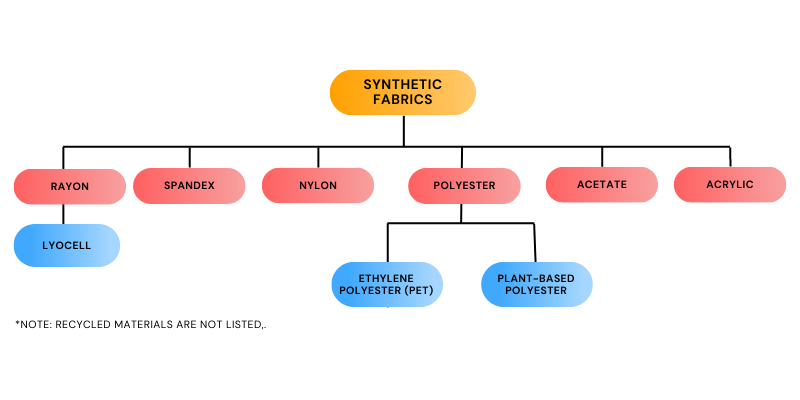A Closer Look into the Material Drivers of the Clothing Industry
July 28, 2022
Many consumers recognize this overproduction’s damage to our planet and are entering a new era of thought. In this green transition, many consumers strive to be socially responsible, seek products with a purpose, and are determined to make environmentally conscious purchases. It has become pertinent that industries become fully transparent about the raw materials, chemicals, and manufacturing processes of their clothing.
Do You Know What’s In Your Clothes?
Today’s garments are assembled from a wide range of substances. These include synthetic fabric materials, fabrics sourced from plants and animals such as leather and cotton, chemicals for the fabric dyeing, processing, and finishing techniques, and various materials such as metals, wood, and plastic for hardware (buttons, zippers, buckles, clasps, etc.).
Notably, most garments are now entirely or partially made from petrochemically-based synthetic fabrics and fibers. In fact, 62% of all fibers that were produced in 2020 are synthetic. While the race towards “perfectly” sustainable synthetics is in motion, most of these experimental fabrics currently make up a slim margin on the global fiber market – about 0.5%.
Petrochemicals, The Dirty Facts: What Are These And What Textiles Have Them?
Petrochemicals are any chemical products derived from petroleum; a fossil fuel often referred to as crude oil. Fossil fuels are a nonrenewable resource, and the petrochemical industry exploits them; the negative environmental impacts are combined with profound social and political implications. In particular, air and water pollution are advancing global warming and environmental injustices, as production and consumption disproportionately affect communities of color and low-income. This begs the question: In the face of climate degradation, why do we continue to use these products?
Petrochemicals create an amazing array of inexpensive and practical resources for multiple industries; from vehicles and electronics to laundry detergent, nearly everything we use today is powered by or made of petrochemicals.
In the apparel industry, petroleum-based fibers are found in 4 primary fabrics: polyester, acrylics, nylon, and spandex.
- Polyester is the most widely used fiber in the world. It is a
thermoplastic, a plastic polymer that becomes malleable at certain
elevated temperatures and solidifies upon cooling. It has many
beneficial and expansive properties, such as microbial resistance,
elasticity, and its ability to be strong as steel and light as paper.
Its durability affords peak wash and wear performance. In stark
contrast, the material also creates environmental malignancy by
producing microplastics and greenhouse gas (GHG) emissions during
production, to name a few.
- Nylon, a manufactured polyamide (as opposed to silk and wool, which are naturally occurring), is one of the US’s most widely used synthetic fabrics. This thermoplastic is known for its durability, stain, and abrasion resistance, which hold high value in products like pantyhose. However, to produce nylon, you release nitrous oxide, a greenhouse gas with a significant global warming potential 300 times that of carbon dioxide. In addition to this, the material creates microplastic pollution when washed.
- Acrylic is a synthetic fiber; its appeal is its wool-like feel without the expensive price tag or rigorous regime for upkeep. Again, these polymers, in addition to being inexpensive, have high durability and stain resistance. However, they are made of acrylonitrile, a carcinogen, and a mutagen. This substance can cause health problems, chiefly headache, nausea, dizziness, difficulty breathing, and many more based on exposure.
- Spandex, also known as elastane or lycra, is simultaneously tight, elastic, lightweight, breathable, and occasionally comfortable. Just like polyester, we heavily rely on this synthetic fabric. You can find it in your swimwear and athleisure apparel. And, like polyester, spandex, when produced, releases GHGs and, when burned in landfills, releases carbon into the air and contributes to rising air pollution levels.

While these fabrics make up a significant fraction of the fabric market, several other synthetic fabrics and filaments are depicted above. None of these materials are biodegradable, thus will not decay naturally and persist in the environment indefinitely, especially as microplastics on land, in the air, or in the ocean.
We are all striving to educate ourselves on the origins of our clothing and use this information to make more informed and eco-friendly-driven decisions about our wardrobes. For some simple tips to fill an environmentally-friendly closet with a wardrobe that looks great and lasts a long time check out our toolkit.
To learn more about sustainable fashion, test your knowledge, and find out what you can do to stand up to fast fashion, visit EARTHDAY.ORG’s Fashion for the Earth site. It is time for consumers to take matters into their own hands when fighting for the environment, garment workers, and our collective future.
Many people I know already do, or have now started to buy second hand clothes. We don't have that many here on Menorca but sometimes it is possible to grab a really good make of clothing for a great price, while also donating to charity and helping the planet too! It is a win-win situation! I managed to pick up a pair of Levi jeans for the great price of 3.50 euro.
Another good thing is the emergence of the apps like "Vinted" designed to do the same thing!
The blog song for today is: "Strange Days"by the Doors
TTFN



No comments:
Post a Comment